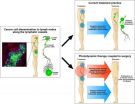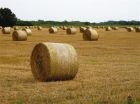(Press-News.org) Cultivating coca bushes, the source of cocaine, is speeding up destruction of rainforests in Colombia and threatening the region's "hotspots" of plant and animal diversity, scientists are reporting in a new study. The findings, which they say underscore the need for establishing larger protected areas to help preserve biodiversity, appear in ACS' journal Environmental Science & Technology.
Liliana M. Dávalos and colleagues note that the pace of deforestation in Colombia has accelerated over the past 20 years, even as population growth has slowed and the economy has shifted from agriculture to other revenue sources. Colombia's increase in deforestation overlaps with an increase in the cultivation of coca for cocaine production, and the country accounted for 75 percent of the world's coca in 2000. But direct deforestation from coca is what the authors described as relatively small, with as little as 58 square miles of forests replaced by coca each year by 2005. Since rainforests contain about 10 percent of the world's plant and animal species — some of which become the basis of new medicines — deforestation represents a serious threat to global biodiversity. With studies suggesting that coca cultivation contributes to deforestation indirectly, the scientists set out to further document this impact.
Their analysis of data from 2002-2007 on the effects of coca cultivation on deforestation of rainforests in Colombia identified several factors that boosted the likelihood that rainforest would be destroyed. In southern Colombia forest close to newly developed coca farms, for instance, was likely to be cut, as was land in areas where much of the farmland was devoted to coca. This is the first time the indirect impact on deforestation from cultivation destined for the global cocaine market has been quantified across South America's biodiversity hotspots. They also showed that designating protected areas, regions that are set aside for special protection for environmental reasons, reduced forest destruction in coca-growing areas. Establishing larger protected areas in the region could help control deforestation and preserve biodiversity, the report suggests.
###
ARTICLE FOR IMMEDIATE RELEASE
"Forests and Drugs: Coca-Driven Deforestation in Tropical Biodiversity Hotspots"
DOWNLOAD FULL TEXT ARTICLE
http://pubs.acs.org/stoken/presspac/presspac/full/10.1021/es102373d
CONTACT:
Liliana Dávalos, Ph.D.
Department of Ecology and Evolution
SUNY Stony Brook
Stony Brook, New York 11794-5245
Phone: 631-632-1554
Email: ldavalos@life.bio.sunysb.edu
Cocaine production increases destruction of Colombia's rainforests
2011-02-10
ELSE PRESS RELEASES FROM THIS DATE:
Greener process for key ingredient for everything from paint to diapers
2011-02-10
Scientists are reporting discovery of an environmentally friendly way to make a key industrial material — used in products ranging from paints to diapers — from a renewable raw material without touching the traditional pricey and increasingly scarce petroleum-based starting material. Their report on a new catalyst for making acrylic acid appears in ACS Catalysis, the newest in the American Chemical Society's suite of 39 peer-reviewed scientific journals.
Weijie Ji, Chak-Tong Au, and colleagues note that acrylic acid is essential for making paints, adhesives, textiles, ...
Toward a fast, simple test for detecting cholera rampaging in 40 countries
2011-02-10
With cholera on the rampage in Haiti and almost 40 other countries, scientists are reporting the development of a key advance that could provide a fast, simple test to detect the toxin that causes the disease. The report appears in ACS' journal Bioconjugate Chemistry. Cholera affects more than 200,000 people annually, mainly in developing countries, and causes about 5,000 deaths. Many involve infants, children, and the elderly.
J. Manuel Perez and colleagues note that cholera is an intestinal infection from food or water contaminated with the bacterium Vibrio cholerae. ...
A green way to cap an old landfill
2011-02-10
This release is available in Spanish.
U.S. Department of Agriculture (USDA) scientist Pat Millner and safety manager David Prevar have worked with the U.S. Environmental Protection Agency (EPA) and private consultants to design and conduct a pilot study for an alternative way to cap landfills.
Millner is a microbiologist at the 6,615-acre Henry A. Wallace Beltsville Agricultural Research Center (BARC) operated in Beltsville, Md., by the Agricultural Research Service (ARS), the chief intramural scientific research agency of USDA.
Prevar oversees safety and health issues ...
Photodynamic therapy against cancer
2011-02-10
Tumor cells have several routes that enable them to move from the primary tumor to distant tissues, a process called metastasis. It is metastasis of the primary tumor that kills most cancer patients. One of the least studied routes of metastasis is the lymphatic system. Many tumors produce factors that promote the formation of new lymphatic vessels (lymphangiogenesis). The newly formed lymphatic vessels enable tumor cells to travel from the primary tumor to the regional lymph nodes from whence they can spread throughout the body.
Current treatment practice is to surgically ...
Challenges for biofuels: New life cycle assessment report from Energy Biosciences Institute
2011-02-10
A combination of rising costs, shrinking supplies, and concerns about global climate change are spurring the development of alternatives to the burning of fossil fuels to meet our transportation energy needs. Scientific studies have shown the most promising of possible alternatives to be liquid fuels derived from cellulosic biomass. These advanced new biofuels have the potential to be clean-burning, carbon-neutral and renewable. Some could also be delivered through existing pipelines and used in today's engines, replacing gasoline on a gallon-for-gallon basis with no loss ...
AGU journal highlights -- Feb. 9, 2011
2011-02-10
No tipping point for Arctic Ocean ice, study says
Using microearthquakes to evaluate potential carbon sequestration sites
Observing flares from Jupiter's aurora
Change in atmospheric patterns behind Arctic sea ice summer 2010 low
Antarctic ice sheet melting would affect sea ice margin, marine food chain
Simulating ocean carbon storage during the Last Glacial Maximum
Anyone may read the scientific abstract for any already-published paper by clicking on the link provided at the end of each Highlight. You can also read the abstract by going to http://www.agu.org/pubs/search_options.shtml ...
Night games in sports stadiums and street lighting can cause spike in daytime ozone air pollution
2011-02-10
Brightly-lit Cowboys Stadium during Sunday's Super Bowl XLV may symbolize one of the hottest new pieces of scientific intelligence about air pollution: Researchers have discovered — in a classic case of scientific serendipity — that the bright light from sports stadiums and urban street lights may boost daytime levels of ozone, a key air pollutant in many heavily populated areas. That's among the topics included in a broader article about the chemistry of air pollution in the current edition of Chemical & Engineering News (C&EN), ACS' weekly newsmagazine.
In the article, ...
Young people now take longer to join adult life
2011-02-10
A research study by the Autonomous University of Barcelona (UAB), in collaboration with the State University of Campinas (Brazil), shows that young Spanish people were by 2001 taking six years longer than in 1981 to reach full employment, residential and family independence.
Spain considers itself to be a "family-centred" country, in other words, families are expected to take up the slack with regard to areas not covered by social security. "The objective was to evaluate transformations in the trends of how young people gained their independence in Spain over the last ...
Sweeping view of prostate cancer genome yields deep insights
2011-02-10
NEW YORK, CAMBRIDGE, Mass., AND BOSTON (Feb. 9, 2011) -- For the first time, researchers have laid bare the full genetic blueprint of multiple prostate tumors, uncovering alterations that have never before been detected and offering a deep view of the genetic missteps that underlie the disease. The study, made possible by key advances in whole genome sequencing and analysis, points to several new prostate cancer genes and a critical category of genomic changes as important drivers of prostate cancer growth. The work was led by researchers from Weill Cornell Medical College, ...
What makes fructose fattening? OHSU researchers find some answers in the brain
2011-02-10
PORTLAND, Ore. – The dietary concerns of too much fructose is well documented. High-fructose corn syrup has become the sweetener most commonly added to processed foods. Many dietary experts believe this increase directly correlates to the nation's growing obesity epidemic. Now, new research at Oregon Health & Science University demonstrates that the brain – which serves as a master control for body weight – reacts differently to fructose compared with another common sweetener, glucose. The research is published in the online edition of the journal Diabetes, Obesity and ...


